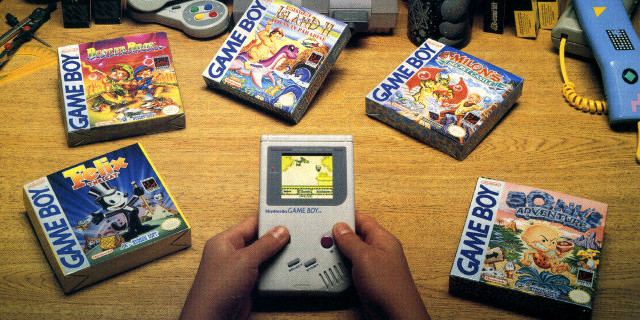
A video game is an electronic game that involves interaction with a user interface to generate visual feedback on a screen.
The electronic systems used to play video games are called platforms. Video games are developed and released for one or several platforms and may not be available on others.
The history of video games goes as far back as the early 1950s, when academic scientists began designing simple games and simulations as part of their research or just for fun. Video gaming did not reach popularity until the 1970s and 1980s, when video arcade games and gaming consoles using joysticks, buttons, and other controllers, along with graphics on computer screens and home computer games were introduced to the public.

The early history of video games covers the period of time between the first interactive electronic game with an electronic display in 1947 and the rise of early arcade video games in the 1970s. With the advances of computing technology, there was a wide range of devices and inventions during this time. There is still a dispute over what the actual first video game is, depending on the definition of "video game" used.
Various research institutions created games (generally simulating real-world board games) to explore programming, human–computer interaction, and computer algorithms.
As computing technology improved over time, computers became smaller and faster, and also students had the chance to work on them by the end of the 1950s. These new programmers began to create games for non-academic purposes, leading up to the 1962 release of Spacewar! as one of the earliest known digital computer games to be available outside a single research institute.

The golden age of video games was the era when the video games became a dominant cultural force. The exact time period is disputed, but key moments include the release of Space Invaders (Taito, 1978) and the vector-based Asteroids (Atari, 1979). This was made possible by the increase in power and decrease in cost of computing technology. This led to the rise of both video game arcades and the mention of video games in other media, such as songs, cartoons, and movies like 1982's TRON. Other iconic games from this era include Pac-Man, Defender, Galaga, Donkey Kong, and Centipede.
The golden age was a time of great technical and design creativity in arcade games, which became more popular than pinball machines. The sales of arcade video game machines increased significantly during this period.
With the enormous success of the early games, many developers jumped into the development and manufacturing of video arcade games. Some simply copied the idea of Space Invaders and turned out successful imitators (like for example Galaxian or Galaga), others tried new concepts and defined new genres. This togheter with the rapidly evolving hardware allowed new kinds of games like Pacman, Rally-X, Donkey Kong, Qix, and many others.

Although in the early 80’s the video game industry was booming, in 1983, the video game industry was hit with a huge recession. At that period, the video game industry was still a fraction of the size that it is today. Because of a drop of revenues of almost 97 percent, many companies producing video games, especially smaller third-party development companies, were forced to shut down. Also toy stores, who had been the main distributors for video games, concluded that they were just a fad and stopped promoting them in stores.
The crash was attributed to several factors. First of all, there was an over saturation in the video game console market. By 1983, gamers had dozens of console choices to pick from. As a consequence, there was little continuity throughout gaming with friends. A second problem was that, after the success the video game industry experienced in the late 70’s and early 80’s, many companies were rushing to produce video games as quickly as possible. This trend of bad games culminated with several flops that financially crippled video game companies (the most frequently cited example of this is the video game E.T., which is considered the worst video game of all time! - see: Videogames buried in New Mexico).
The final contributing factor to the crash was the waning interest in console games in favor of personal computers (think about the Commodore 64 that went on to become one of the best selling computers of all time.
The video game console industry eventually recovered a few years later, mostly due to the widespread success of the Nintendo Entertainment System (NES) in 1985.

The 1990s were a decade of innovation in video gaming. Polygons took over for pixels. The transition from raster graphics to 3D graphics gave rise to several video games of new genres lije first-person shooter, real-time strategy, and MMO.
Console systems began to move to the new CD-ROM technology, with the Nintendo 64 being the last major home video game console to use ROM cartridges. Due to CD-ROMs lacking the built-in memory of ROM Cartridges, the Sony PlayStation introduced the use of memory cards to store saved game data. This became the standard for video game consoles until it was replaced by the use of hard drives.
The optional Rumble Pak for the Nintendo 64 controller introduced the use of haptic force feedback technology in gaming.
In 1999 the Sega Dreamcast introduced the use of pressure-sensitive buttons.
Handheld gaming began to become more popular throughout the decade, starting wirh the release of the Game Boy in 1989. Arcade games experienced a resurgence in the early-to-mid-1990s, followed by a decline in the late 1990s as home consoles became more common.

In 1999 the Dreamcast provided built in modem, internet browsing software, and ability to play certain games online. Nearly all consoles since released then have had support for online gaming, which in previous generations had been the exclusive domain of PC games. Nevertheless, due to lack of widespread broadband adoption at the time, the Dreamcast had no wide success.
The PlayStation 2 did not initially ship with built-in networking capabilities. Microsoft, however, hoped that the Xbox would succeed where the Dreamcast had failed. In 2002, Xbox Live was launched. Initially the console only used a feature called system link, where players could connect two consoles using an Ethernet cable, or multiple consoles through a router. Xbox Live allowed shared play over the internet. A similar feature for PlayStation 3 will be the "PlayStation Network", and for the Wii the "Nintendo Network".
Entering into the 2000s, online gaming grew in massively multiplayer online games, with World of Warcraft (2004) dominating much of the decade.
The drawback of online games is that thay are not permanently playable, unlike purchased retail games, as they require special servers in order to function.
The culture of online gaming sometimes faces criticisms for an environment that can promote cyberbullying, violence, and xenophobia, and can cause addiction or social stigma.
Since online games have attracted players from a variety of ages, nationalities, and occupations, they have also been studied from a social point of view in the scientific field.

The 2010s was notable for producing the first truly "3D" games and consoles, introducing cloud gaming and virtual reality to consumers, and the rising influence of tablet-based and mobile casual games.
The industry remained heavily dominated by the actions of Nintendo, Sony, and Microsoft, but it remains unforeseen how their dominance will be affected by cloud gaming and the growing smartphone and tablet market. To make things worst, the financial crisis that struck in the late-2000s affected the video game industry: video games were perceived to be a luxury item.


